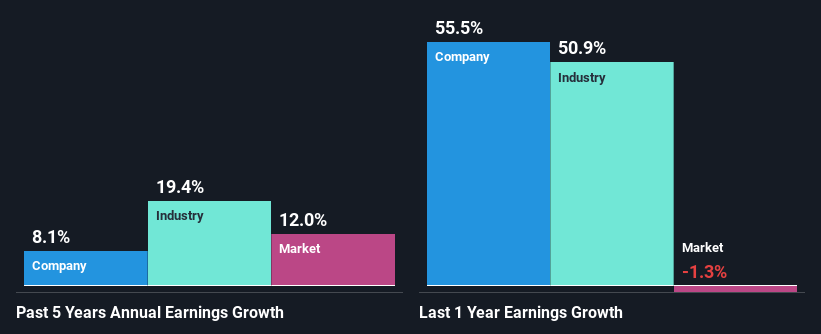Do Fundamentals Have Any Role To Play In Driving Boustead Singapore Limited's (SGX:F9D) Stock Up Recently?
Most readers would already know that Boustead Singapore's (SGX:F9D) stock increased by 5.4% over the past three months. We wonder if and what role the company's financials play in that price change as a company's long-term fundamentals usually dictate market outcomes. In this article, we decided to focus on Boustead Singapore's ROE.
ROE or return on equity is a useful tool to assess how effectively a company can generate returns on the investment it received from its shareholders. Put another way, it reveals the company's success at turning shareholder investments into profits.
See our latest analysis for Boustead Singapore
How Is ROE Calculated?
ROE can be calculated by using the formula:
Return on Equity = Net Profit (from continuing operations) ÷ Shareholders' Equity
So, based on the above formula, the ROE for Boustead Singapore is:
10% = S$59m ÷ S$586m (Based on the trailing twelve months to September 2023).
The 'return' refers to a company's earnings over the last year. That means that for every SGD1 worth of shareholders' equity, the company generated SGD0.10 in profit.
Why Is ROE Important For Earnings Growth?
We have already established that ROE serves as an efficient profit-generating gauge for a company's future earnings. We now need to evaluate how much profit the company reinvests or "retains" for future growth which then gives us an idea about the growth potential of the company. Assuming all else is equal, companies that have both a higher return on equity and higher profit retention are usually the ones that have a higher growth rate when compared to companies that don't have the same features.
A Side By Side comparison of Boustead Singapore's Earnings Growth And 10% ROE
On the face of it, Boustead Singapore's ROE is not much to talk about. Yet, a closer study shows that the company's ROE is similar to the industry average of 10%. Even so, Boustead Singapore has shown a fairly decent growth in its net income which grew at a rate of 8.1%. Given the slightly low ROE, it is likely that there could be some other aspects that are driving this growth. Such as - high earnings retention or an efficient management in place.
As a next step, we compared Boustead Singapore's net income growth with the industry and were disappointed to see that the company's growth is lower than the industry average growth of 19% in the same period.
Earnings growth is an important metric to consider when valuing a stock. The investor should try to establish if the expected growth or decline in earnings, whichever the case may be, is priced in. By doing so, they will have an idea if the stock is headed into clear blue waters or if swampy waters await. Is Boustead Singapore fairly valued compared to other companies? These 3 valuation measures might help you decide.
Is Boustead Singapore Making Efficient Use Of Its Profits?
With a three-year median payout ratio of 39% (implying that the company retains 61% of its profits), it seems that Boustead Singapore is reinvesting efficiently in a way that it sees respectable amount growth in its earnings and pays a dividend that's well covered.
Besides, Boustead Singapore has been paying dividends for at least ten years or more. This shows that the company is committed to sharing profits with its shareholders. Our latest analyst data shows that the future payout ratio of the company over the next three years is expected to be approximately 36%. Accordingly, forecasts suggest that Boustead Singapore's future ROE will be 10% which is again, similar to the current ROE.
Summary
Overall, we feel that Boustead Singapore certainly does have some positive factors to consider. That is, a decent growth in earnings backed by a high rate of reinvestment. However, we do feel that that earnings growth could have been higher if the business were to improve on the low ROE rate. Especially given how the company is reinvesting a huge chunk of its profits. That being so, a study of the latest analyst forecasts show that the company is expected to see a slowdown in its future earnings growth. To know more about the latest analysts predictions for the company, check out this visualization of analyst forecasts for the company.
Have feedback on this article? Concerned about the content? Get in touch with us directly. Alternatively, email editorial-team (at) simplywallst.com.
This article by Simply Wall St is general in nature. We provide commentary based on historical data and analyst forecasts only using an unbiased methodology and our articles are not intended to be financial advice. It does not constitute a recommendation to buy or sell any stock, and does not take account of your objectives, or your financial situation. We aim to bring you long-term focused analysis driven by fundamental data. Note that our analysis may not factor in the latest price-sensitive company announcements or qualitative material. Simply Wall St has no position in any stocks mentioned.

 Yahoo Finance
Yahoo Finance 
